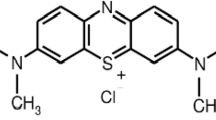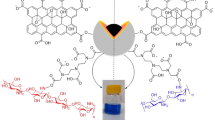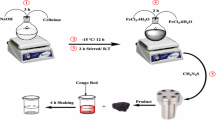Abstract
Herein, a magnetically separable Fe3O4 decorated chitosan was facilely synthesized, systematically characterized, and subsequently employed as a versatile adsorbing material for the adsorption of malachite green and methylene blue dyes. The prepared adsorbent was characteristically examined through Fourier transform infra-red microscopy, scanning electron microscopy with energy-dispersive X-ray analysis, transmission electron microscopy, X-ray diffraction, Brunauere-Emmette-Teller surface area analysis, thermogravimetric analysis, and vibrating-sample magnetometry techniques. The optimum process parameters for MB were observed to be 180 min of contact time, pH 7, and 1.2 g/L of adsorbent dose, and 210 min of contact time, pH 7, and adsorbent dose of 2 g/L was found to be for MG. The time-dependent experimental data were analyzed with different kinetic models, and pseudo-IInd-order was provided the best fit for the adsorption of both the dyes with a high value of the regression coefficient. The adsorption equilibrium data of both the dyes was best explained by Langmuir isotherm, and the maximum sorption capacity of MG and MB was found to be 55.86 and 76.34 mg/g, respectively. Thermodynamic analysis declared that the adsorption of MG and MB onto the Fe3O4 decorated chitosan was endothermic and spontaneous. Moreover, the adsorbent presented good reusability up to three successive ad-/de-sorption cycles, indicating that Fe3O4 decorated chitosan is a promising applicant for treating dye-containing wastewater.











Similar content being viewed by others
Data availability
Not applicable.
References
Franco EG, Kastner A, Kuritzky M, Lukacs R (2019) Regional risks for doing business 2019. World Econ Forum 1–40. https://www.weforum.org/reports/regional-risks-for-doing-business-2019. Accessed 1 Oct 2019
Novais RM, Ascensão G, Tobaldi DM et al (2018) Biomass fly ash geopolymer monoliths for effective methylene blue removal from wastewaters. J Clean Prod 171:783–794. https://doi.org/10.1016/j.jclepro.2017.10.078
Ippolito A, Fait G (2019) Pesticides in surface waters: from edge-of-field to global modelling. Curr Opin Environ Sustain 36:78–84. https://doi.org/10.1016/j.cosust.2018.10.023
Kant R (2012) Textile dyeing industry an environmental hazard. Nat Sci 4:22–26. https://doi.org/10.4236/ns.2012.41004
Qamruzzaman NA (2014) Kinetics of metribuzin degradation by colloidal manganese dioxide in absence and presence of surfactants. Chem Pap 68:65–73. https://doi.org/10.2478/s11696-013-0424-7
Qamruzzaman NA (2014) Treatment of acetamiprid insecticide from artificially contaminated water by colloidal manganese dioxide in the absence and presence of surfactants. RSC Adv 4:62844–62850. https://doi.org/10.1039/c4ra09685a
Quesada HB, Baptista ATA, Cusioli LF et al (2019) Surface water pollution by pharmaceuticals and an alternative of removal by low-cost adsorbents: A review. Chemosphere 222:766–780. https://doi.org/10.1016/j.chemosphere.2019.02.009
Zhao F, Repo E, Yin D, Sillanpää MET (2013) Adsorption of Cd(II) and Pb(II) by a novel EGTA-modified chitosan material: kinetics and isotherms. J Colloid Interface Sci 409:174–182. https://doi.org/10.1016/j.jcis.2013.07.062
Zhao F, Repo E, Yin D et al (2015) EDTA-cross-linked β-Cyclodextrin: an environmentally friendly bifunctional adsorbent for simultaneous adsorption of metals and cationic dyes. Environ Sci Technol 49:10570–10580. https://doi.org/10.1021/acs.est.5b02227
Qamruzzaman NA (2015) Degradation of acephate by colloidal manganese dioxide in the absence and presence of surfactants. Desalin Water Treat 55:2155–2164. https://doi.org/10.1080/19443994.2014.937752
Agarwal A, Verma AK, Yoshida M et al (2020) A novel catalytic kinetic method for the determination of mercury (II) in water samples. RSC Adv 10:25100–25106. https://doi.org/10.1039/D0RA03487H
Jain SN, Tamboli SR, Sutar DS et al (2020) Batch and continuous studies for adsorption of anionic dye onto waste tea residue: Kinetic, equilibrium, breakthrough and reusability studies. J Clean Prod 252:119778. https://doi.org/10.1016/j.jclepro.2019.119778
Jain SN, Shaikh Z, Mane VS et al (2019) Nonlinear regression approach for acid dye remediation using activated adsorbent: Kinetic, isotherm, thermodynamic and reusability studies. Microchem J 148:605–615. https://doi.org/10.1016/j.microc.2019.05.024
Taqui SN, Mohan CS, Khatoon BA et al (2021) Sustainable adsorption method for the remediation of malachite green dye using nutraceutical industrial fenugreek seed spent. Biomass Convers Biorefinery. https://doi.org/10.1007/s13399-021-01827-w
Nasar A (2021) Utilization of tea wastes for the removal of toxic dyes from polluted water—a review. Biomass Convers Biorefinery. https://doi.org/10.1007/s13399-020-01205-y
Mashkoor F, Nasar A (2020) Magnetized Tectona grandis sawdust as a novel adsorbent: preparation, characterization, and utilization for the removal of methylene blue from aqueous solution. Cellulose 27:2613–2635. https://doi.org/10.1007/s10570-019-02918-8
Uddin MK, Mashkoor F, AlArifi IM, Nasar A (2021) Simple one-step synthesis process of novel MoS2@bentonite magnetic nanocomposite for efficient adsorption of crystal violet from aqueous solution. Mater Res Bull 139:111279. https://doi.org/10.1016/j.materresbull.2021.111279
Nasar A, Mashkoor F (2019) Application of polyaniline-based adsorbents for dye removal from water and wastewater—a review. Environ Sci Pollut Res 26:5333–5356
Kang S, Qin L, Zhao Y et al (2020) Enhanced removal of methyl orange on exfoliated montmorillonite/chitosan gel in presence of methylene blue. Chemosphere 238:124693. https://doi.org/10.1016/j.chemosphere.2019.124693
Jafari S, Zhao F, Zhao D et al (2015) A comparative study for the removal of methylene blue dye by N and S modified TiO2 adsorbents. J Mol Liq 207:90–98. https://doi.org/10.1016/j.molliq.2015.03.026
Shakoor S, Nasar A (2016) Removal of methylene blue dye from artificially contaminated water using citrus limetta peel waste as a very low cost adsorbent. J Taiwan Inst Chem Eng 66:154–163. https://doi.org/10.1016/j.jtice.2016.06.009
Zambrano-Intriago LA, Gorozabel-Mendoza ML, Córdova Mosquera A et al (2020) Kinetics, equilibrium, and thermodynamics of the blue 19 dye adsorption process using residual biomass attained from rice cultivation. Biomass Convers Biorefinery. https://doi.org/10.1007/s13399-020-00944-2
Mashkoor F, Nasar A (2020) Magsorbents: potential candidates in wastewater treatment technology – A review on the removal of methylene blue dye. J Magn Magn Mater 500:166408. https://doi.org/10.1016/j.jmmm.2020.166408
Mashkoor F, Nasar A, Inamuddin, (2020) Carbon nanotube-based adsorbents for the removal of dyes from waters: a review. Environ Chem Lett 18:605–629. https://doi.org/10.1007/s10311-020-00970-6
Hokkanen S, Bhatnagar A, Sillanpää M (2016) A review on modification methods to cellulose-based adsorbents to improve adsorption capacity. Water Res 91:156–173. https://doi.org/10.1016/j.watres.2016.01.008
Motejadded Emrooz HB, Maleki M, Rashidi A, Shokouhimehr M (2021) Adsorption mechanism of a cationic dye on a biomass-derived micro- and mesoporous carbon: structural, kinetic, and equilibrium insight. Biomass Convers Biorefinery 11:943–954. https://doi.org/10.1007/s13399-019-00584-1
Shakoor S, Nasar A (2018) Utilization of Punica granatum peel as an eco-friendly biosorbent for the removal of methylene blue dye from aqueous solution. J Appl Biotechnol Bioeng 5:242–249. https://doi.org/10.15406/jabb.2018.05.00145
Lou T, Yan X, Wang X (2019) Chitosan coated polyacrylonitrile nanofibrous mat for dye adsorption. Int J Biol Macromol 135:919–925. https://doi.org/10.1016/j.ijbiomac.2019.06.008
Sabar S, Aziz HA, Yusof NH et al (2020) Preparation of sulfonated chitosan for enhanced adsorption of methylene blue from aqueous solution. React Funct Polym 151:104584. https://doi.org/10.1016/j.reactfunctpolym.2020.104584
Vakili M, Deng S, Cagnetta G et al (2019) Regeneration of chitosan-based adsorbents used in heavy metal adsorption: a review. Sep Purif Technol 224:373–387. https://doi.org/10.1016/j.seppur.2019.05.040
Fan L, Luo C, Li X et al (2012) Fabrication of novel magnetic chitosan grafted with graphene oxide to enhance adsorption properties for methyl blue. J Hazard Mater 215–216:272–279. https://doi.org/10.1016/j.jhazmat.2012.02.068
Chen B, Zhao H, Chen S et al (2019) A magnetically recyclable chitosan composite adsorbent functionalized with EDTA for simultaneous capture of anionic dye and heavy metals in complex wastewater. Chem Eng J 356:69–80. https://doi.org/10.1016/j.cej.2018.08.222
Mashkoor F, Nasar A (2020) Facile synthesis of polypyrrole decorated chitosan-based magsorbent: Characterizations, performance, and applications in removing cationic and anionic dyes from aqueous medium. Int J Biol Macromol 161:88–100. https://doi.org/10.1016/j.ijbiomac.2020.06.015
Mashkoor F, Nasar A, Inamuddin AAM (2018) Exploring the reusability of synthetically contaminated wastewater containing crystal violet dye using Tectona grandis sawdust as a very low-cost adsorbent. Sci Rep 8:8314. https://doi.org/10.1038/s41598-018-26655-3
Jabar JM, Odusote YA (2021) Utilization of prepared activated biochar from water lily (Nymphaea lotus) stem for adsorption of malachite green dye from aqueous solution. Biomass Convers Biorefinery. https://doi.org/10.1007/s13399-021-01399-9
Singh S, Prajapati AK, Chakraborty JP, Mondal MK (2021) Adsorption potential of biochar obtained from pyrolysis of raw and torrefied Acacia nilotica towards removal of methylene blue dye from synthetic wastewater. Biomass Convers Biorefinery. https://doi.org/10.1007/s13399-021-01645-0
Prasad AR, Joseph A (2017) Synthesis, characterization and investigation of methyl orange dye removal from aqueous solutions using waterborne poly vinyl pyrrolidone (PVP) stabilized poly aniline (PANI) core–shell nanoparticles. RSC Adv 7:20960–20968. https://doi.org/10.1039/C7RA01790A
Bagheri H, Roostaie A, Baktash MY (2014) A chitosan-polypyrrole magnetic nanocomposite as μ-sorbent for isolation of naproxen. Anal Chim Acta 816:1–7. https://doi.org/10.1016/j.aca.2014.01.028
Qi L, Tang X, Wang Z, Peng X (2017) Pore characterization of different types of coal from coal and gas outburst disaster sites using low temperature nitrogen adsorption approach. Int J Min Sci Technol 27:371–377. https://doi.org/10.1016/j.ijmst.2017.01.005
Saravanakumar R, Muthukumaran K, Selvaraju N (2019) Enhanced Pb (II) ions removal by using magnetic NiO/Biochar composite. Mater Res Express 6:105504. https://doi.org/10.1088/2053-1591/ab2141
Kazeminezhad I, Mosivand S (2014) Phase transition of electrooxidized Fe3O4 to γ and α-Fe2O3 nanoparticles using sintering treatment. Acta Phys Pol A 125:1210–1214. https://doi.org/10.12693/APhysPolA.125.1210
Zhu Y, Xue J, Xu T et al (2017) Enhanced photocatalytic activity of magnetic core–shell Fe3O4@Bi2O3–RGO heterojunctions for quinolone antibiotics degradation under visible light. J Mater Sci Mater Electron 28:8519–8528. https://doi.org/10.1007/s10854-017-6574-6
Cao C, Xiao L, Chen C et al (2014) In situ preparation of magnetic Fe3O4/chitosan nanoparticles via a novel reduction–precipitation method and their application in adsorption of reactive azo dye. Powder Technol 260:90–97. https://doi.org/10.1016/j.powtec.2014.03.025
Cabuk M, Alan Y, Yavuz M, Unal HI (2014) Synthesis, characterization and antimicrobial activity of biodegradable conducting polypyrrole-graft-chitosan copolymer. Appl Surf Sci 318:168–175. https://doi.org/10.1016/j.apsusc.2014.02.180
Du Q, Sun J, Li Y et al (2014) Highly enhanced adsorption of congo red onto graphene oxide/chitosan fibers by wet-chemical etching off silica nanoparticles. Chem Eng J 245:99–106. https://doi.org/10.1016/j.cej.2014.02.006
Bayramoglu G, Altintas B, Arica MY (2009) Adsorption kinetics and thermodynamic parameters of cationic dyes from aqueous solutions by using a new strong cation-exchange resin. Chem Eng J 152:339–346. https://doi.org/10.1016/j.cej.2009.04.051
Mashkoor F, Nasar A (2019) Preparation, characterization and adsorption studies of the chemically modified Luffa aegyptica peel as a potential adsorbent for the removal of malachite green from aqueous solution. J Mol Liq 274:315–327. https://doi.org/10.1016/j.molliq.2018.10.119
Wang P, Ma Q, Hu D, Wang L (2015) Removal of reactive Blue 21 onto magnetic chitosan microparticles functionalized with polyamidoamine dendrimers. React Funct Polym 91–92:43–50. https://doi.org/10.1016/j.reactfunctpolym.2015.04.007
Tan KL, Hameed BH (2017) Insight into the adsorption kinetics models for the removal of contaminants from aqueous solutions. J Taiwan Inst Chem Eng 74:25–48. https://doi.org/10.1016/j.jtice.2017.01.024
Mane VS, Vijay Babu PV (2013) Kinetic and equilibrium studies on the removal of Congo red from aqueous solution using Eucalyptus wood (Eucalyptus globulus) saw dust. J Taiwan Inst Chem Eng 44:81–88. https://doi.org/10.1016/j.jtice.2012.09.013
Sewu DD, Jung H, Kim SS et al (2019) Decolorization of cationic and anionic dye-laden wastewater by steam-activated biochar produced at an industrial-scale from spent mushroom substrate. Bioresour Technol 277:77–86. https://doi.org/10.1016/j.biortech.2019.01.034
Machado Garcia R, Carleer R, Arada Pérez M et al (2020) Adsorption of Cibacron Yellow F-4G dye onto activated carbons obtained from peanut hull and rice husk: kinetics and equilibrium studies. Biomass Convers Biorefinery. https://doi.org/10.1007/s13399-020-00699-w
Zayed AM, Abdel Wahed MSM, Mohamed EA, Sillanpää M (2018) Insights on the role of organic matters of some Egyptian clays in methyl orange adsorption: Isotherm and kinetic studies. Appl Clay Sci 166:49–60. https://doi.org/10.1016/j.clay.2018.09.013
Foo KY, Hameed BH (2010) Insights into the modeling of adsorption isotherm systems. Chem Eng J 156:2–10. https://doi.org/10.1016/j.cej.2009.09.013
Zhang Y, Gao W, Kong F, Fatehi P (2021) Adsorption thermodynamics of cationic dye on hydrolysis lignin-acrylic acid adsorbent. Biomass Convers Biorefinery. https://doi.org/10.1007/s13399-021-01659-8
Arumugam TK, Krishnamoorthy P, Rajagopalan NR et al (2019) Removal of malachite green from aqueous solutions using a modified chitosan composite. Int J Biol Macromol 128:655–664. https://doi.org/10.1016/j.ijbiomac.2019.01.185
Hasan I, Bhatia D, Walia S, Singh P (2020) Removal of malachite green by polyacrylamide-g-chitosan γ-Fe2O3 nanocomposite-an application of central composite design. Groundw Sustain Dev 11:100378. https://doi.org/10.1016/j.gsd.2020.100378
Bekçi Z, Özveri C, Seki Y, Yurdakoç K (2008) Sorption of malachite green on chitosan bead. J Hazard Mater 154:254–261. https://doi.org/10.1016/j.jhazmat.2007.10.021
Naseeruteen F, Hamid NSA, Suah FBM et al (2018) Adsorption of malachite green from aqueous solution by using novel chitosan ionic liquid beads. Int J Biol Macromol 107:1270–1277. https://doi.org/10.1016/j.ijbiomac.2017.09.111
Li X, Li J, Sun X et al (2015) Preparation and malachite green adsorption behavior of polyurethane/chitosan composite foam. J Cell Plast 51:373–386. https://doi.org/10.1177/0021955X14542538
Debrassi A, Corrêa AF, Baccarin T et al (2012) Removal of cationic dyes from aqueous solutions using N-benzyl-O-carboxymethylchitosan magnetic nanoparticles. Chem Eng J 183:284–293. https://doi.org/10.1016/j.cej.2011.12.078
Rahmi I, Mustafa I (2019) Methylene blue removal from water using H2SO4 crosslinked magnetic chitosan nanocomposite beads. Microchem J 144:397–402. https://doi.org/10.1016/j.microc.2018.09.032
Cho D-W, Jeon B-H, Chon C-M et al (2015) Magnetic chitosan composite for adsorption of cationic and anionic dyes in aqueous solution. J Ind Eng Chem 28:60–66. https://doi.org/10.1016/j.jiec.2015.01.023
Marrakchi F, Khanday WA, Asif M, Hameed BH (2016) Cross-linked chitosan/sepiolite composite for the adsorption of methylene blue and reactive orange 16. Int J Biol Macromol 93:1231–1239. https://doi.org/10.1016/j.ijbiomac.2016.09.069
Mokhtar A, Abdelkrim S, Djelad A et al (2020) Adsorption behavior of cationic and anionic dyes on magadiite-chitosan composite beads. Carbohydr Polym 229:115399. https://doi.org/10.1016/j.carbpol.2019.115399
Zeng L, Xie M, Zhang Q et al (2015) Chitosan/organic rectorite composite for the magnetic uptake of methylene blue and methyl orange. Carbohydr Polym 123:89–98. https://doi.org/10.1016/j.carbpol.2015.01.021
Yan H, Li H, Yang H et al (2013) Removal of various cationic dyes from aqueous solutions using a kind of fully biodegradable magnetic composite microsphere. Chem Eng J 223:402–411. https://doi.org/10.1016/j.cej.2013.02.113
Ahmed M, Mashkoor F, Nasar A (2020) Development, characterization, and utilization of magnetized orange peel waste as a novel adsorbent for the confiscation of crystal violet dye from aqueous solution. Groundw Sustain Dev 10:100322. https://doi.org/10.1016/j.gsd.2019.100322
Mashkoor F, Nasar A (2019) Polyaniline/Tectona grandis sawdust: a novel composite for efficient decontamination of synthetically polluted water containing crystal violet dye. Groundw Sustain Dev 8:390–401. https://doi.org/10.1016/j.gsd.2018.12.008
Kuo C-Y, Wu C-H, Wu J-Y (2008) Adsorption of direct dyes from aqueous solutions by carbon nanotubes: Determination of equilibrium, kinetics and thermodynamics parameters. J Colloid Interface Sci 327:308–315. https://doi.org/10.1016/j.jcis.2008.08.038
Tehrani-Bagha AR, Nikkar H, Mahmoodi NM et al (2011) The sorption of cationic dyes onto kaolin: kinetic, isotherm and thermodynamic studies. Desalination 266:274–280. https://doi.org/10.1016/j.desal.2010.08.036
Acknowledgements
The authors thank the Chairperson of the Department of Applied Chemistry, Faculty of Engineering and Technology, AMU, for extending laboratory facilities.
Author information
Authors and Affiliations
Contributions
F.M. performed the experiments. A.N. supervised the work. A.N. and C.J. analyzed and interpreted the experimental data and assisted F.M. in manuscript writing. All the authors discussed the data and agreed to submit the manuscript.
Corresponding author
Ethics declarations
Conflict of interest
The authors declare no conflict of interest.
Additional information
Publisher's note
Springer Nature remains neutral with regard to jurisdictional claims in published maps and institutional affiliations.
Supplementary Information
Below is the link to the electronic supplementary material.
Rights and permissions
About this article
Cite this article
Mashkoor, F., Nasar, A. & Jeong, C. Magnetized chitosan nanocomposite as an effective adsorbent for the removal of methylene blue and malachite green dyes. Biomass Conv. Bioref. 14, 313–325 (2024). https://doi.org/10.1007/s13399-021-02282-3
Received:
Revised:
Accepted:
Published:
Issue Date:
DOI: https://doi.org/10.1007/s13399-021-02282-3




